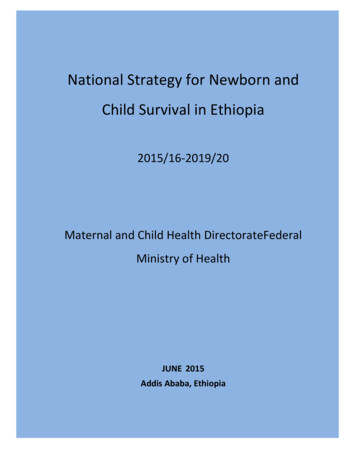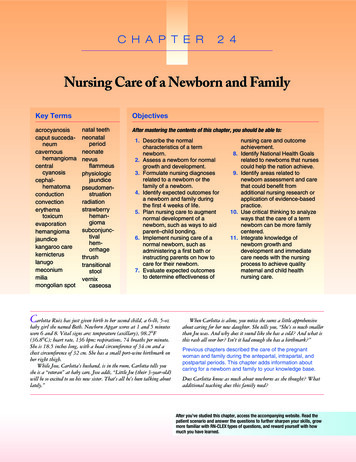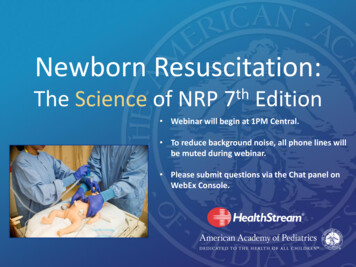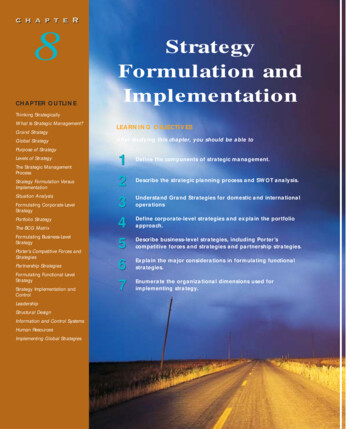
Transcription
National Strategy for Newborn andChild Survival in Ethiopia2015/16-2019/20Maternal and Child Health DirectorateFederalMinistry of HealthJUNE 2015Addis Ababa, Ethiopia
National Strategy for Newborn and Child Survival in Ethiopia, 2015/16 – 2029/20National Strategy for Newborn and ChildSurvival in Ethiopia(2015/16 – 2019/20)Maternal and Child Health DirectorateFederal Ministry of HealthJUNE 2015Addis Ababa, Ethiopia1
Table of ContentsTable of Contents . 1ACRONYMS . 5FOREWORD . 6ACKNOWLEDGEMENTS . 8EXECUTIVE SUMMARY . 21. INTRODUCTION AND RATIONALE . 52: BACKGROUND . 73: NEWBORN AND CHILD HEALTH IN ETHIOPIA . 103.1 The Health System . 173.1.1 Primary Level Health Care . 193.1.2 Community Empowerment, Engagement and Participation . 193.1.3 Secondary and Tertiary Level Health Care . 203.2 Management and Support . 213.3 Health Service Quality. 213.4 Health Care Financing . 223.4.1 Total Health Expenditure . 223.4.2 Financing Channels and Arrangement . 233.4.2 Health insurance . 244: NEWBORN AND CHILD SURVIVAL STRATEGIC FRAMEWORK . 254.1 Vision . 254.2 Goals . 254.3 Objectives . 254.4 Guiding Principles . 265: KEY NEWBORN AND CHILD SURVIVAL INTERVENTIONS . 275.1 Target conditions for child survival . 275.2 Priority High Impact Interventions for newborn and child survival . 301
National Strategy for Newborn and Child Survival in Ethiopia, 2015/16 – 2029/206: SERVICE DELIVERY LEVELS AND STRATEGIES . 366.1.1 Community Based Interventions . 39Essential medicines, commodities and logistics . 39Capacity of HEWs . 39Provide counseling and care at home and health posts . 39Monitoring, supervision and reporting . 396.1.2 Population Oriented Outreach Services . 40Essential medicines, commodities and logistics . 40Capacity of Health workers and HEWs . 40Provision of outreach counseling and care . 40Monitoring and supervision . 406.1.3 Individual Oriented Clinical Services . 40Essential medicines, commodities and logistics . 41Capacity of Health workers . 41Infrastructure . 41Provision of individual oriented clinical care . 41Monitoring and evaluation . 426.2.1 Community Based Interventions . 43Availing essential medicines, commodities and logistics. 43Capacity building for HEWs . 43Community empowerment and demand creation . 43Provision of basic family-level counseling and curative services. 436.2.2 Population Oriented Outreach Services . 44Essential medicines, commodities and logistics . 44Capacity of Health workers and HEWs . 44Provision of outreach counseling and care . 44Monitoring and supervision . 446.2.3 Individual Oriented Clinical Services . 44Essential medicines, commodities and logistics . 44Capacity of Health workers . 452
National Strategy for Newborn and Child Survival in Ethiopia, 2015/16 – 2029/20Provision of individual oriented clinical care . 456.3.1 Community Based Interventions . 46Community empowerment and Demand Creation . 466.3.2 Population Oriented Outreach Services . 47Community mobilization for services uptake . 476.3.3 Individual Oriented Clinical Services . 476.4 Supporting Strategies. 486.4.1 Resource mobilization. 486.4.2 Human Resources for Health . 486.4.3 Logistics Management . 496.5 Implementation of the Strategy . 506.5.1 Health care for the newborns and children in regions requiring equitable development andspecial population segments, including pastoralist and cross-border mobile communities . 506.5.2 Public Private Partynership for implementation of the Newborn and Child Survival Strategy . 516.5.3 Intersectoral and MultiSectoral Co-opration for implementation of the Newborn and ChildSurvival Strategy . 517: PARTNERSHIPS, ROLES & RESPONSIBILITIES . 527.1 Partnerships for the Newborn and Child Survival in Ethiopia . 527.2 Roles and Responsibilities . 53Federal Ministry of Health . 53National Reproductive, Maternal, Newborn, Child and Adolescent Health (RMNCAH) and NutritionTechnical Working group . 53National Newborn and Child Survival Sub-Technical Working Group . 54Regional RMNCAH & Nutrition Technical Working Group . 54Woreda RMNCAH & Nutrition Committee . 55Kebelle Health Development Team . 55Health Development Army . 56Health Facilities (health Centers & Hospitals) . 56Health Training Institutions & Professional Associations . 563
National Strategy for Newborn and Child Survival in Ethiopia, 2015/16 – 2029/208: MONITORING & EVALUATION . 588.1 Regular performance tracking system . 588.2 Operations research, studies and evaluation. . 599: COSTING AND IMPACT ESTIMATION . 609.1 Costing methodology . 619.3 Costing results . 629.4 Limitations of current cost estimates . 6310: REFERENCES . 6411: ANNEXES . 67ANNEX 1 - Intervention packages and selected indicators for monitoring the strategy . 674
National Strategy for Newborn and Child Survival in Ethiopia, 2015/16 – SNNPRTTAcquired Immune Deficiency SyndromeAntenatal CareCommunicable Disease ControlCommunity Integrated Management of Childhood IllnessesDemographic and Health SurveyEssential Nutrition ActionExpanded Program on ImmunizationFederal Democratic Republic of EthiopiaFederal Ministry of HealthHealth Development ArmyHIV/AIDS Prevention and Control OfficeHealth Extension PackageHuman Immunodeficiency VirusHealth Management Information SystemHealth Sector Development ProgramHealth Sector Transformation PlanInteragency Coordinating CommitteeInformation Education CommunicationIntegrated Management of Newborn and Childhood IllnessesInfant Mortality RateInfant and Young Child FeedingKangaroo Mother CareJoint Steering CommitteeLive birthsMaternal and Child HealthMillennium Development GoalMaternal Mortality RatioNewborn and Child Survival StrategyNational Immunization DaysNeonatal Mortality RatePrevention of Mother to Child TransmissionPrimary Health Care UnitPrimary Health CareRegional Health BureausSustainable Development & Poverty Reduction ProgramSupplementary Immunization ActivitiesSub-National Immunization DaysSouthern Nations & Nationalities and Peoples RegionTetanus Toxoid5
National Strategy for Newborn and Child Survival in Ethiopia, 2015/16 – 2029/20FOREWORDEthiopia has made impressive progress through achiving many of the national and global healthindicators as a result of strong leadership of the Federal Ministry of Health (FMOH),coordination of efforts and intensive investment in the health system by the government,partners and the community at large. The country achieved MDG 4 target in 2012 three yearsahead of 2015 by reducing under-five mortality by two thirds from its 1990 level. The NationalChild Survival Strategy (2005 – 2015) and the Child Survival Partnership were instrumental inguiding the design, implementation,coordination, monitoring and evaluation of high impactnewborn and child health intervetnions in the country.Whilst celebrating the achivements made through successful implementation of the NationalChild Survival Strategy (2005 – 2015) FMOH dully recognizes that the current under-five andneonatal mortality rates of 64 and 29 per 1,000 live births, respectively, is unacceptably high.The ministry also acknowledges that neonatal mortality rate is disproportionally highaccounting to 44% of under-five deaths. In addition, neonatal and under-five mortality ratesvary across income, gender, and geographical areas. Cognizant of this Ethiopia has envisionedto end all preventable newborn and child deaths by 2035. To this effect in 2012 Ethiopia has ledthe development of the “Promise Renewed Child survival Roadmap” with a commitment to endpreventable child death with the goal of dropping under-five mortality rate to less than20/1,000 live births by 2035.Effective coverage for life saving high impact newborn and child health interventions has beensteadly increasing. However, the access to and utilization of the interventions have not beenuniform across all sections of the the population and different geographical areas. Building onthe success recorded in accelerated expansion of the health services throughout the countrythrough implementation of the four cycles of Health Sector Development Plans (HSDPs) FMOHwill work with Regional Health Bureaus (RHBs) and its health development partners to ensureuniversal coverage of quality high impact newborn and child survival interventions. Addressinginequity and ensuring quality service delivery, prioritized guiding priniciples in the Health SectorTransformation Plan (HSTP) 2015/16 – 2019/20, will also guide the implementation of thisstrategy.The National Newborn and Child Survival Strategy (2015/16-2019/20), which will be part of theHSTP covering same period, aims to reduce under five mortality from 64/1,000 live births (2013level) to 29/1,000 live births, infant mortality rate from 44/1000 live births to 20/1000 livebirths and NMR from 28/1,000 live births to 11/1,000 live births. The strategy plans to ensureuniversal coverage of quality high impact newborn and child health interventions along withmeaningful community empowerment to create demand for the services.6
National Strategy for Newborn and Child Survival in Ethiopia, 2015/16 – 2029/20The strategy identified and prioritized 39 high impact and cost effective newborn and childsurvival interventions with key guiding principles for implementation of the strategy includingequity and accessibility; community engagement, empowerment and ownership; integration;partnership; efficient use of resources; innovation and use of technology; evidence baseddecision making; and provision of quality MNCH services. A sustained government andpartner’s commitment, the Primary Health Care Unit with its home grown innovative HealthExtension Program that utilizes the Health Development Army as platform for socialmobilization, and strengthened referral and linkage will continue to be the basis for continuedgains in newborn and child health.7
National Strategy for Newborn and Child Survival in Ethiopia, 2015/16 – 2029/20ACKNOWLEDGEMENTSThe Federal Ministry of Health would like to acknowledge the National Child Survival TechnicalWorking Group for their invaluable technical contributions throughout the development of theNational Newborn and Child Survival Strategy (2015/16 – 2019/20).The Ministry would like to extend a special acknowledgement to the following institutions andpartners that provided professional experts and other support during the development of thestrategy document.FMOH – diferrent directoratesAAU/ /GenevaWHO/AFROWHO/EthiopiaSave the Children piaWater Aid/Ethiopia8
National Strategy for Newborn and Child Survival in Ethiopia, 2015/16 – 2029/20EXECUTIVE SUMMARYIn Ethiopia, under-five mortality rate has declined by two thirds from the 1990 figure of204/1,000 live births to 68/1,000 live births in 2012, thus meeting the target for MillenniumDevelopment Goal 4 (MDG 4) on child survival three years ahead of time. In absolute numbersthe under-five deaths in Ethiopia has declined from nearly half a million, 444,000 a year in1990, to about 196,000 in 2013. However, the mortality reduction was not uniform across thedifferent childhood age groups, geographic and socio-demographic population groups.Disaggregation of the mortality data by age reveals that the decline in neonatal mortality is notas impressive as the infant and child mortality figures. It has fallen only by 42% during the sameperiod; from 54/1000 live births in 1990 to 28/1000 live births in 2013. About 44% of thechildhood deaths occur within the first 28 days of life, thus increasingly accounting for a largerproportion of the under five deaths. There is also wide geographic variation in under-fivemortality according to the EDHS 2011 ranging from as low as 53/1000 live births in Addis Ababato as high as 169/1000 live births in Benishangul-Gumuz region. Similarly, significant variation isalso observed among different socio-economic groups within the same geographic areas.Over two-thirds of childhood deaths in Ethiopia are caused by few and easily preventableconditions; mainly infections, neonatal conditions and malnutrition. The major direct causes ofunder five mortality, based on the 2014 WHO/CHERG estimates are pneumonia (18%), diarrhea(9%), prematurity (11%), newborn infection (9%), asphyxia (14%), injury (6%), measles (2%),malaria (3%), congenital anomalies (4%), HIV (2%), and others (21%). Under nutrition is a majorunderlying cause contributing to nearly half of childhood deaths. Even though underweight,stunting and wasting has declined by 39%, 31% and 25% respectively during the last 15 years,the 2014 mini EDHS estimates of stunting (40%), underweight (25%) and wasting (9%) are stillvery high.The MOH developed the first comprehensive National Child Survival Strategy (2005-2015) in2005 which was being implemented as part of the 3 rd and 4th HSDP cycles. The implementationof this strategy had boosted the child survival efforts of the country through improvedcoordination, partnership, resource mobilization and scale up of high impact interventions. As aresult of these efforts, Ethiopia has recorded significant reduction in childhood mortality andhad achieved the MDG4 target in 2012. Several factors are believed to contribute to thereduction in under five mortality including the improvement in overall socio-economic statusand the significant increase in access to primary health care services, from 68% in 2005 to 92%in 2010. In terms of interventions; reductions in malnutrition, increases in vaccination, VitaminA, ITNs, family planning and water & sanitation were the main contributors for theimprovements in child survival in the last two decades.2
National Strategy for Newborn and Child Survival in Ethiopia, 2015/16 – 2029/20Even though 2005 – 2015 National Strategy for Child Survival provided the means for achievingthe MDG4 goal, several global and national developments had happened during the last eightyears necessitating revision of the strategy. A number of new interventions includingcommunity management of childhood illness (pneumonia, diarrhea, malaria, malnutrition) andneonatal sepsis (CBNC), community based nutrition (CBN), Heamophlusinflueanza type bvaccine, hepatitis vaccine, Pneumococcal & Rota virus vaccines, and “Option B ” for PMTCT,were already introduced. Other new high impact interventions including corticosteroids forpreterm labor at hospital level and chlorhexidine for cord care at community and facility levelare in the process of introduction to address the high neonatal mortality.There is also a need to scale up existing high impact interventions whose population coveragelags behind the target such as skilled birth attendance & early postnatal care; and treatmentinterventions including ORS & Zinc, antibiotics for pneumonia, ACT for malaria and ART for HIVinfected children. In line with the current focus on facility delivery, clean and safe delivery byHEW is no longer included in the list of newborn and child survival interventions in areas wherethere are accessible health centers.Thus, the revision of the current strategy was imperative to consolidate the encouraging gainsin child survival and the long-term vision of the country to end all preventable child deaths by2030.The goal of this National Newborn and Child Survival Strategy (2015-2020) is to reduce underfive mortality from 64/1,000 (2013 level) to at least 29 /1,000, infant mortality rate from44/1000 to 20/1000 and NMR from 28 to 11/1,000 by 2020.This strategy would be implemented in line with other relevant national strategic plansincluding; HSTP (HSDP V), the Roadmap for Accelerated Reduction of Maternal and NewbornMortality, the National Nutrition Program, the EPI Comprehensive Multi-Year Plan, the Nationalstrategic Plan for Malaria Prevention Control & Elimination, the National strategic Plan forElimination of MTCT of HIV, One WASH National Program, iCCM and CBNC implementationplan. The strategy is also linked to the post MDG agenda – the commitment of government ofEthiopia for ending preventable child mortality in a generation time.The key guiding principles for implementation of the revised strategy focus on: equity andaccessibility; community engagement, empowerment and ownership; efficient use ofresources; innovation and use of evidence based interventions, provision of quality MNCHservices, strong monitoring and dissemination of best practices.A package of 34 high impact and cost effective newborn and child survival interventions areprioritized with coverage targets for 2019/20. The continuum of care approach will be used to3
National Strategy for Newborn and Child Survival in Ethiopia, 2015/16 – 2029/20rollout the delivery of the selected high impact newborn and child health intervetionsaddressing particular needs of women and children across time (pre-pregnancy, pregnancy,delivery, postnatal period, infancy and childhood) and the different mix of the interventions arepackaged to be delivered at household/community, population oriented outreach services andindividualized clinical care levels. In rural area health posts, health centers and primaryhospitals will serve as service delivery points while the health development army platform willbe used to empower and engage the community. In urban areas the first entry to the healthsystem will be health centers that will provide basic and emergency care for communities,hospitals will serve as referral facilities for advanced newborn and child health care. Healthdevelopment army working hand in hand with the urban health extension workers will be thecrucial community networks that will mobilize communities and engage them in the planningand implementation newborn and child health services in urban. The strategy emphasizes theneed for intensified effort in regions requiring equitable development to address the visible gapin survival and development of newborns and children across regions.Optimal implementation of the key interventions will prevent deaths of 415,688 and 210,234under-five and neonatal deaths, respectively, over the period of five years. Optimalimplementation of the selected newborn and child survival interventions requires mobilizing atotal of US 1.16 billion (ETB 23.2 billion) in five year period. Existing funding channels (channel1a, channel 1b, channel 2 and channel 3) will continue to be used as financing arrangement inthe implementation the intervetions through direct funding by the government or by healthdevelopment partners. In addition, the FMOH will strengthen its effort to expand the fund baseof the Technical Assistance Pooled Fund and will work with the health development partners tocontinue the MDG Performance Fund after the end of the MDG period in some form or shape.FMOH will also work with regional governments and health bureaus to scale up the CommunityBased and Social Health Insurance schemes to insure financial sustainability of the healthsystem.National newborn and child survival partnerships and coordination platforms will bestrengthened at all levels (from national to Wereda levels) under the leadership of the FMOH.Structures to scale up selected newborn and child survival interventions will be strengthenedthrough harmonization of efforts and mobilization of needed resources. Progress will bemonitored annually using standard indicators. HMIS, population surveys including the EDHS in2015 and 2020 will be used to monitor progress over years and evaluate achievement of theplanned targets.4
National Strategy for Newborn and Child Survival in Ethiopia, 2015/16 – 2029/201. INTRODUCTION AND RATIONALEEthiopia has made considerable progress in reducing under-five mortality rate. According to the2014 UN Inter-agency Group for Child Mortality Estimation (UN-IGME) report, Ethiopia is one ofthe eight high-mortality countries (together with Bangladesh, Malawi, Nepal, Liberia, UnitedRepublic of Tanzania, Timor – Leste, Niger and Eritrea) where the under 5 mortality hasdeclined by two thirds, thus achieving MDG4 three years ahead of the 2015 deadline (UNIGME,2014). However, children still continue to die of easily preventable and treatable diseases forwhich low cost and effective interventions exist. In addition, there has not been significantreduction in neonatal mortality(WHO, 2014). Much remains to be done to maintain gains in thelast two decades and accelerate progress to reach post MDG targets, thus calling for a revisionof the current child survival strategy.The National Strategy for Child Survival developed in 2005, provided platform forimplementation of key interventions to reduce child mortality in line with achieving themillennium development goal related to reduction of child deaths by two third. Since itsdevelopment in 2005 several evidence-based interventions that need to be incorporated in thestrategy have been initiated. These include community management of pneumonia throughIntegrated Community Case Management (iCCM); community based newborn sepsismanagement through the Community Based Newborn Care (CBNC); Newborn Intensive CareUnit (NICU); Newborn Corner; introduction of Hemophilus Influenzae, Pneumococcal, and Rotavirus vaccines to EPI; and shift of PMTCT to “Option B ”.Moreover, a changing landscape due to population dynamics, urbanization, double burden ofcommunicable and non-communicable diseases as well as malnutrition, industrialization,globalization, climate change and technologies indicate the need for continuous update ofglobal and national strategies. It is therefore necessary to develop a follo
Child Survival Strategy (2005 - 2015) FMOH dully recognizes that the current under-five and neonatal mortality rates of 64 and 29 per 1,000 live births, respectively, is unacceptably high. The ministry also acknowledges that neonatal mortality rate is disproportionally high accounting to 44% of under-five deaths. .










